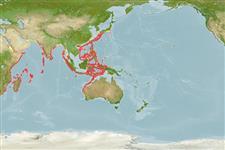>
Scombriformes (Mackerels) >
Gempylidae (Snake mackerels)
Etymology: Neoepinnula: Greek, neos = new + Latin ex = outside + Latin, diminutive of pinna = spiny (Ref. 45335).
Environment: milieu / climate zone / depth range / distribution range
Ecología
marino bentopelágico; rango de profundidad 200 - 570 m (Ref. 6181). Deep-water; 37°N - 31°S, 32°E - 140°E (Ref. 6181)
Indo-West Pacific: off East Africa (Kenya to Natal, South Africa), Saya de Malha Bank, Arabian Sea; eastern North Indian Ocean, Flores, Banda, Arafura Sea, Sulawesi and Sulu seas, off Ryukyu Islands and southern Japan. Reported from Fiji and Tuvalu (Ref. 12596).
Tamaño / Peso / Age
Maturity: Lm ? range ? - ? cm
Max length : 30.0 cm SL macho / no sexado; (Ref. 6181)
Espinas dorsales (total) : 17; Radios blandos dorsales (total) : 17 - 20; Espinas anales: 3; Radios blandos anales: 17 - 19. There are two lateral lines on the sides, both originating from above the upper angle of the gill opening. Overall color is greenish brown to dark brown. The buccal and branchial cavities are usually black.
Feeds on small fishes, crustaceans and cephalopods (Ref. 30573). Matures at about 15 cm SL.
Life cycle and mating behavior
Maturities | Reproducción | Spawnings | Egg(s) | Fecundities | Larva
Nakamura, I. and N.V. Parin, 1993. FAO Species Catalogue. Vol. 15. Snake mackerels and cutlassfishes of the world (families Gempylidae and Trichiuridae). An annotated and illustrated catalogue of the snake mackerels, snoeks, escolars, gemfishes, sackfishes, domine, oilfish, cutlassfishes,. scabbardfishes, hairtails, and frostfishes known to date. FAO Fish. Synop. 125(15):136 p. (Ref. 6181)
IUCN Red List Status (Ref. 130435)
Threat to humans
Harmless
Human uses
Pesquerías: pesquerías de subsistencia
Herramientas
Special reports
Download XML
Fuentes de Internet
Estimates based on models
Preferred temperature (Ref.
123201): 9.2 - 15.7, mean 11.9 °C (based on 148 cells).
Phylogenetic diversity index (Ref.
82804): PD
50 = 0.7500 [Uniqueness, from 0.5 = low to 2.0 = high].
Bayesian length-weight: a=0.00269 (0.00152 - 0.00477), b=3.05 (2.89 - 3.21), in cm total length, based on LWR estimates for this species & (Sub)family-body (Ref.
93245).
Nivel trófico (Ref.
69278): 4.2 ±0.58 se; based on food items.
Resiliencia (Ref.
120179): Alto, población duplicada en un tiempo mínimo inferior a 15 meses (Preliminary K or Fecundity.).
Fishing Vulnerability (Ref.
59153): Low to moderate vulnerability (27 of 100).
Nutrients (Ref.
124155): Calcium = 25.9 [12.2, 61.1] mg/100g; Iron = 0.387 [0.168, 0.844] mg/100g; Protein = 17 [15, 19] %; Omega3 = 0.458 [0.226, 0.917] g/100g; Selenium = 17.2 [6.8, 38.0] μg/100g; VitaminA = 18.7 [3.9, 86.0] μg/100g; Zinc = 0.423 [0.291, 0.643] mg/100g (wet weight); based on
nutrient studies.
